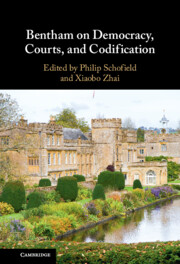Book contents
- Bentham on Democracy, Courts, and Codification
- Bentham on Democracy, Courts, and Codification
- Copyright page
- Contents
- Contributors
- Introduction
- Part I Democracy
- Part II Law and the Courts
- 8 Between Constructivism and Immanentism
- 9 A Genius for Legislation
- 10 Indirect Legislation in Bentham’s Late Constitutional Writings
- 11 Bentham, Courts, and Democracy
- Part III Codification
- Bibliography
- Index
11 - Bentham, Courts, and Democracy
from Part II - Law and the Courts
Published online by Cambridge University Press: 25 August 2022
- Bentham on Democracy, Courts, and Codification
- Bentham on Democracy, Courts, and Codification
- Copyright page
- Contents
- Contributors
- Introduction
- Part I Democracy
- Part II Law and the Courts
- 8 Between Constructivism and Immanentism
- 9 A Genius for Legislation
- 10 Indirect Legislation in Bentham’s Late Constitutional Writings
- 11 Bentham, Courts, and Democracy
- Part III Codification
- Bibliography
- Index
Summary
My chapter examines a neglected feature of Bentham’s design for representative democracy in his Constitutional Code. This is the lengthy plan for the judicial branch of government, set out in the final volume of the three-volume Code. Of the many influential advocates for constitutional democracy of his era, Bentham was unique in devoting such systematic attention to courts and judicial procedure. His constitutional programme included a detailed system for a dense network of local courts providing free and rapid adjudication of legal disputes. At the same time, Bentham rejected judicial functions now associated with liberal constitutionalism, such as the protection of entrenched rights and the preservation of constitutional norms. Instead, he emphasized the institutions and public resources required to ensure equal access to justice for the weakest members of the community. This emphasis helps clarify Bentham’s larger political strategy for advancing the happiness of the community and the manner in which he understood the specifically democratic character of his judicial plan. The latter theme requires special attention since so much of Bentham’s designs for courts and judicial procedure long predated his embrace of democratic radicalism.
- Type
- Chapter
- Information
- Bentham on Democracy, Courts, and Codification , pp. 258 - 284Publisher: Cambridge University PressPrint publication year: 2022



